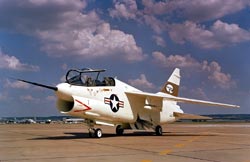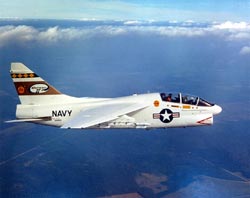|
 From the very beginning of the A-7 Program, LTV sought to sell a two-place version of the airplane. The need was obvious, but at the time the Navy just wasn't interested. "Perhaps a little later, when the program has matured" was their position. In early 1972, Sol Love (who had moved up to the Program Director position because of the untimely death of Connie Lau) convinced General Manager Russ Clark that a company-funded prototype of the two-place version was desirable. This was to be the brilliant move that would sway the Navy toward purchase of this much-needed version of the airplane. Approval was granted and A-7E SerNo 156801 was bailed to LTV by the Navy. In a whirlwind design and manufacturing effort, the V-519 was born. Built on temporary tooling, and making maximum use of A-7E design knowledge and existing parts, the "White Whale", as it affectionately became known, took to the air in August 1972. Later it was redesignated as the YA-7H and ultimately became the YA-7E. From the very beginning of the A-7 Program, LTV sought to sell a two-place version of the airplane. The need was obvious, but at the time the Navy just wasn't interested. "Perhaps a little later, when the program has matured" was their position. In early 1972, Sol Love (who had moved up to the Program Director position because of the untimely death of Connie Lau) convinced General Manager Russ Clark that a company-funded prototype of the two-place version was desirable. This was to be the brilliant move that would sway the Navy toward purchase of this much-needed version of the airplane. Approval was granted and A-7E SerNo 156801 was bailed to LTV by the Navy. In a whirlwind design and manufacturing effort, the V-519 was born. Built on temporary tooling, and making maximum use of A-7E design knowledge and existing parts, the "White Whale", as it affectionately became known, took to the air in August 1972. Later it was redesignated as the YA-7H and ultimately became the YA-7E.
 The YA-7E proved to be the ultimate sales tool and fetched orders for 60 two-place A-7's, known as the TA-7C. In all, orders for two-place A-7's totaled 102 aircraft that were flown by the U.S. Navy, the U.S. Air Force, and the air forces of Greece and Portugal. Company funding of the V-519 was a wise decision indeed. Its value did not end there, because the YA-7E became the company test and demonstration vehicle for hundreds of A-7 modifications and new systems applications. It operated for 13 years in that capacity and was ultimately sold for scrap. However, The old "White Whale" wouldn't die, and was purchased by an ex-military pilot turned Texas business man, and is being rebuilt as a flying airplane (in civilian garb, that is). It is a grand old bird that promises to be around for many more years before it retires to museum life. The YA-7E proved to be the ultimate sales tool and fetched orders for 60 two-place A-7's, known as the TA-7C. In all, orders for two-place A-7's totaled 102 aircraft that were flown by the U.S. Navy, the U.S. Air Force, and the air forces of Greece and Portugal. Company funding of the V-519 was a wise decision indeed. Its value did not end there, because the YA-7E became the company test and demonstration vehicle for hundreds of A-7 modifications and new systems applications. It operated for 13 years in that capacity and was ultimately sold for scrap. However, The old "White Whale" wouldn't die, and was purchased by an ex-military pilot turned Texas business man, and is being rebuilt as a flying airplane (in civilian garb, that is). It is a grand old bird that promises to be around for many more years before it retires to museum life.
A-7:
Genesis of the Navy Attack Bomber, Light (VA(L))
In Comat
Farewell Proud Bird
Aircraft Performance Perspective
|